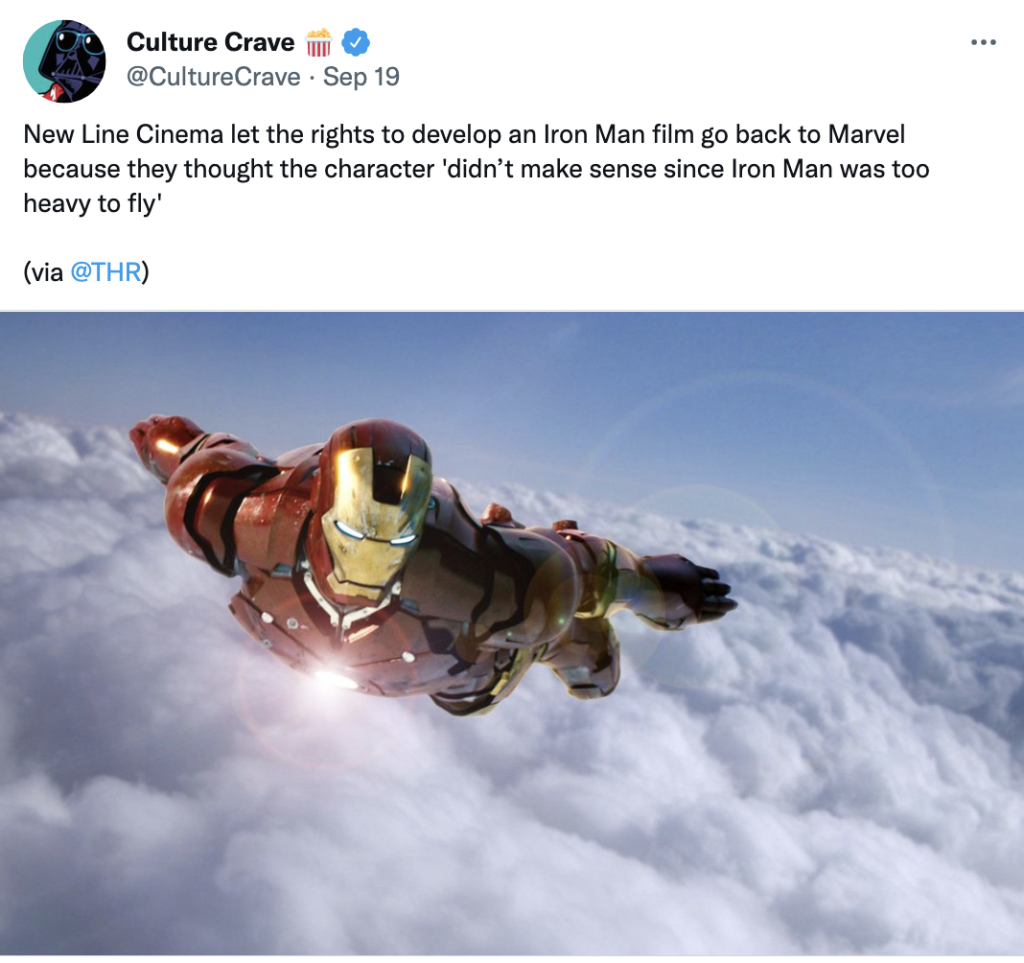Forces of flight and flying suits featured in the second workshop of my project ‘Exploring the Physics of Superheroes’.
On September 16th, the Hollywood Reporter published a piece on the plight of Warner Bros. Discovery and their attempts to reinvigorate the DC film franchise with which they have recently made some very public mistakes.

At the end of the article, an interesting piece of information with regards to Iron Man was revealed. Before the Iron Man film was released in 2008 by Marvel Studios/Paramount Pictures, New Line Cinema had the rights to make the film. However, they let the rights lapse because their CEO thought that it didn’t make sense for the suit to fly as he felt that it was too heavy. Ah hello – it’s popular culture, sometimes things don’t have to make complete sense.
But, did the CEO of New Line Cinema have a point? Have Marvel Studios gone above and beyond what real science and engineering could achieve with their portrayal of the Iron Man suit in the Marvel Cinematic Universe?
This was one of the key questions that I explored during the second workshop of my new superhero education project ‘Exploring the Physics of Superheroes’, a project that I’m doing in collaboration with Midlands Science and which is funded by the Institute of Physics Ireland.
Flight physics 101
Before addressing the New Line Cinema puzzle here, let’s briefly look at some flight physics 101.
Before you start with building a flying machine of some kind, be that a flying suit or an aeroplane, you need to know a little about forces, because forces are essential.
Our world is full forces. Some forces help things to move. Some forces stop things from moving. And some forces seek to be used (Terrible Star Wars joke right here – my apologises). In terms of flight, the flying vehicle of choice for most people is the aeroplane, and when in flight, an aeroplane is subject to four main forces: thrust, weight, drag, and lift.
Thrust is the force generated by the engines of the aeroplane, and it’s this force that helps to push the aeroplane through the air. However, the same air generates a drag force that acts opposite to the direction of the thrust force, and slows down progress in the forward direction.

Perpendicular to the thrust and drag are two more forces: weight and lift. Weight is not the same as mass. The latter is the quantity of matter in an object and measured in kilograms, while the former is the force acting on the object due to gravity. In physics, weight is measured in newtons (N), named after a certain Isaac Newton who helped formulate our understanding of forces, and who did so without getting hit on the head by an apple in an orchard in the 1660s (This is just a story).
Last, but most importantly, is the lift force, which is generated as air moves over the wings of the plane as it moves through the air. If there’s no thrust, then there’s no lift. And if there’s no lift force, then there’s no force to overcome the weight of the aeroplane. If the lift force vanishes, then there’s only one direction for the aeroplane to go, and that is back down to terra firma.
Suit forces
The forces on an Iron Man-like flying suit, are a little more complicated than those experienced by an aeroplane. For one thing, in the MCU films, we see the Iron Man suit flying in all manner of orientations and directions, which is beyond the capabilities of current flying suit technologies (Some of you may sigh at that statement).
However, at initial take-off from the ground, there is little difference between a flying suit and a rocket on a launchpad before lift-off. First, in both cases, weight acts downwards. Second, there’s a force acting upwards, but unlike in aeroplanes, it’s not lift. This time it’s the thrust force generated by the propulsion systems of the suit or rocket. So, you’ve got thrust pointing straight up and the weight pointing straight down. By the way, once they lift off, both the rocket and the suit will start to experience varying degrees of drag and lift forces.
Calculating the mass of the Iron Man suit
That’s the main forces acting on an aeroplane or an Iron Man-like suit when in flight. But if we were to build an Iron Man suit using the same materials as Tony Stark did in the 2008 film Iron Man, would the suit be too heavy? Was the CEO of New Line Cinema right in letting the rights for the film lapse then? Time for a quick calculation.
When someone wears the suit, you’ve got two masses to contend with – the mass of the person and the mass of the suit. Let’s say that the person has a mass between 50 kg and 80 kg. That’s the first mass then. What about the mass of the Iron Man suit? Well to calculate that, I need to make some assumptions – so here goes.

- I’ll assume that the surface area of the skin of a person is 2 m2. This is the area that needs to be covered by the suit. This is the source for this number by the way – I’ve not picked this number off the top of my head.
- Next, I’ll assume that the average thickness of the suit everywhere is 5 cm. I know certain places will be thicker or thinner than others, but this is just a ball park figure for the calculation at hand.
- In the 2008 film Iron Man, Tony Stark mentions that the outside of the suit is made from a gold-titanium alloy. Now, I know the suit is made from lots of other materials too, but for the calculation, I’m going to assume the entire suit is made from a gold-titanium alloy.
- Finally, I need the density of the gold-titanium alloy. For this, I’m going to use a paper published in the journal Science Advances back in 2016 where the researchers mixed different amounts of gold and titanium at high temperatures to create new, super-strong gold-titanium alloys. They found that the hardest gold-titanium alloy between the two has a density of roughly 8,000 kg/m3. So, that’s the density I’ll use for the calculation.
Right, that’s all the information that I need to calculate the mass of the suit. Using the surface area and thickness of the suit, I calculate the volume of the suit as: volume = (surface area)(thickness) = (2)(0.05) = 0.1 m3.
Now, I’ve got the density and volume of the suit. In physics, mass, density, and volume are related to each other by the formula: density = mass/volume. So, using this formula, mass = (density)(volume) = (8000)(0.1) = 800 kg!
My rough calculation gives a suit mass of 800 kg. Adding in the mass of the person means that the suit has a mass of over 850 kg!
So is the Iron Man suit too heavy?
Right, now I can answer the question – was the CEO of New Line Cinema right to not make the Iron Man film based on the fact that suit was too heavy?
Well, an 800-kg suit is quite large. If Tony Stark were in the suit then the mass would be about 870 kg. The force acting on the suit due to gravity – the weight of the suit – is this mass times acceleration due to gravity, which for the Earth is roughly 10 m/s2. This means the weight of the suit plus Tony Stark is 8,700 newtons (N).
To get the suit to fly, Stark would need to create a thrust of at least 8,700 N to get off the ground. Big engines on aeroplanes can generate thrusts of hundreds of kilonewtons, which would easily get the suit to fly. However, those engines are huge, and would be difficult for the wearer to control the suit in flight. Plus they’d have to carry all the fuel for the engine too. I’m sure there’s an engine out there that could provide a thrust of say 10,000 N, but I also think the engine might be big big, too big to fly comfortably.
My calculation is based on lots of assumptions, and it’s probable that the true mass of the suit from the films is far less than 800 kg. However, the CEO of New Line Cinema is probably right – the suit has too much mass to fly with conventional jet engines. Fortunately, Marvel Studios opted to fly the suit using thruster technology, which doesn’t really exist but ensures that the suit can fly in the films.
Perhaps the CEO of New Line Cinema should have abandoned some logic, and leaned on some made-up engineering to get the suit to fly. Because, when it all comes down to it, science fiction films are built upon scientific assumptions and conjecture.
And the absence of some engineering conjecture may very well have cost New Line Cinema in a big way.
Reference materials
Check out the article on the plight of Warners Bros. Discovery in the Hollywood Reporters here.
About ‘Exploring the Physics of Superheroes’
‘Exploring the Physics of Superheroes’ is a new outreach project which allows students to experience the excitement of superheroes whilst learning about the physics that make such stories possible. The project is managed by Midlands Science and delivered by physicist Dr. Barry Fitzgerald (BW Science and The Superhero Scientist), who has done extensive research in this area. The project is supported by the Institute of Physics, whose Limit Less campaign aims to support young people to change the world by doing physics.

